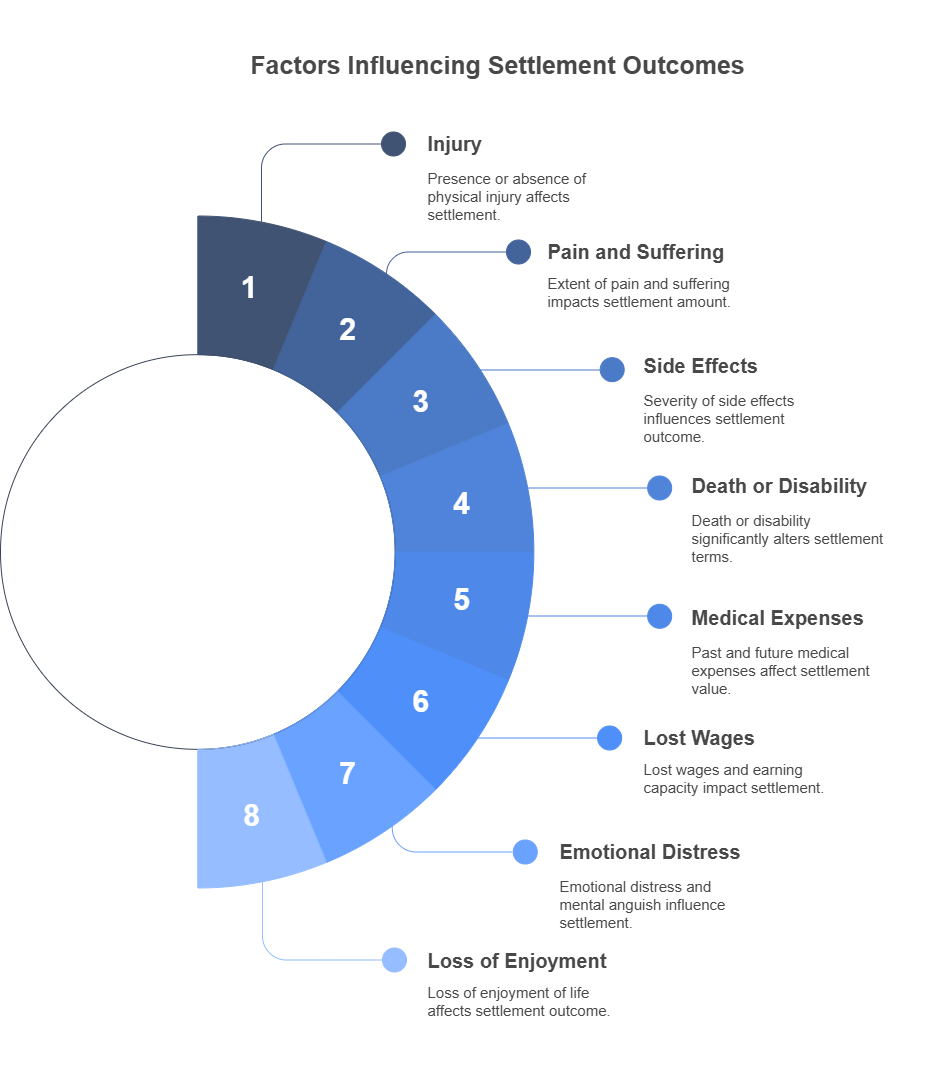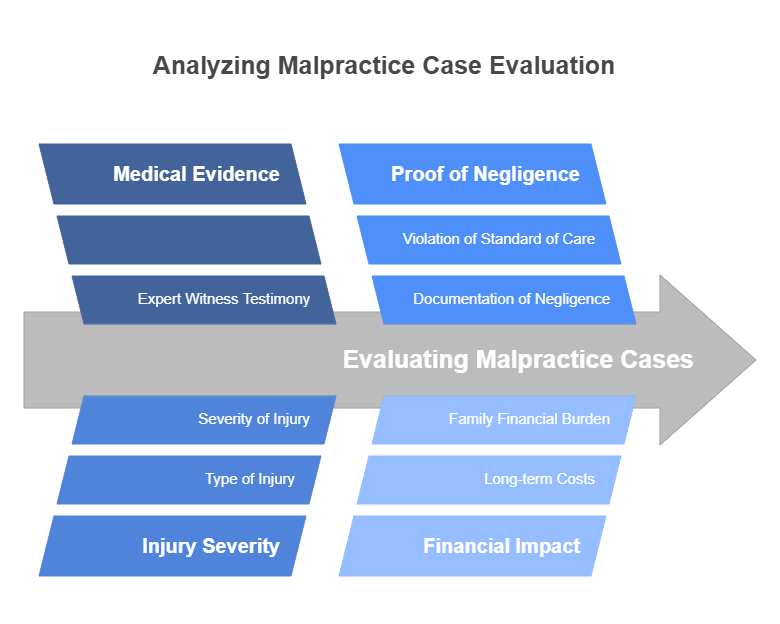
The average medical malpractice settlement in Maryland is around $329,565. However, this figure varies depending on the unique circumstances surrounding each case and can range from $10,000 to $5,000,000+.
Factors such as the severity of the injury, the extent of medical negligence, and the impact on quality of life play roles in determining the final settlement.
Here’s a more detailed breakdown:
- Medical negligence resulting in death: $1,000,000 to $5,000,000
- Surgery malpractice: $200,000 to $5,000,000
- Failure to diagnose: $250,000 to $1,000,000
- Misdiagnosis: $250,000 to $1,000,000
- Medication errors: $100,000 to $905,000+
- Birth injuries: $250,000 to $20,000,000 or more
- Anesthesia errors: $250,000 to $500,000
- Poor follow-up or aftercare: $100,000 to $300,000
- Infections acquired at the hospital: $300,000 to $2,000,000
- IV left in the arm lawsuits: $10,000 for minor tissue damage to over $5,000,000
- Average medical malpractice settlement resulting in death: $400,000 to $5,000,000 or more
- Sepsis malpractice settlements: $250,000 and $1,000,000
- Orthopedic medical malpractice: $300,000 to $1,200,000
In our experience, the figures can be much higher depending on the extent of damages and injuries caused by medical malpractice. In many cases, settlements can reach upwards of millions of dollars, as you’ll see below from some of our case results:
- $5,000,000: A patient was awarded a substantial settlement following a serious injury sustained during a surgical procedure in Baltimore. This significant compensation reflects the severity of the injury and the impact it has had on the patient’s life, covering medical expenses, rehabilitation, and other related costs resulting from the mishap in the operating room.
- $2,500,000: Our lawyers helped secure a substantial $2.5 million settlement for the family of a baby who suffered a significant injury at birth. This settlement aims to cover the extensive medical expenses and long-term care needs of the child, ensuring that they receive the necessary support for a better quality of life moving forward.
- $1,000,000: A case resulted in a $1 million settlement awarded to a patient who suffered from a misdiagnosis of cancer. This unfortunate error not only caused significant emotional distress but also delayed the necessary treatment, highlighting the critical importance of accurate medical assessments and the profound impact of misdiagnoses on patients’ lives.
While we cannot guarantee specific figures for every case, our team of experienced medical malpractice attorneys works tirelessly to secure the best possible outcome for each client.
Final settlement will vary depending on several factors:
- Whether or not there was an injury
- Pain and suffering
- Minor or major side effects
- Death or permanent disability
- Past and future medical expenses
- Lost wages and loss of earning capacity
- Emotional distress and mental anguish
- Loss of enjoyment of life
The more severe the injury and damages, the higher the potential settlement amount is likely to be. More so if the malpractice resulted in death or if it’s evident that the medical professional responsible was grossly negligent or acted in a manner contrary to their duty of care.
Additional reading: how to get a malpractice attorney to take your case

Need help with getting the maximum payout for medical negligence?
At Frank Spector Law, we are dedicated to assisting clients with medical malpractice and personal injury cases throughout Maryland and Washington, D.C. With over 30 years of experience, we provide personalized attention to every case.
If you have questions or need guidance regarding your legal concerns, don’t hesitate to reach out to us at 443-232-2492 for a free case evaluation. We understand the complexity of medical malpractice cases and are committed to fighting for your rights and getting you the compensation you deserve!
We have a Baltimore medical malpractice lawyer on hand for a free consultation
Stand Up for Your Rights
Take the first step toward justice with a free consultation directly with Frank Spector

Direct attorney contact
Decades of courtroom experience
Personal, judgment-free case reviews
Typical medical negligence settlement amounts
Medical negligence cases encompass a wide range of scenarios, each bearing unique implications for settlements:
| Type of Medical Malpractice | Estimated Settlement Range |
|---|---|
| Medical negligence resulting in death | $1,000,000 to $5,000,000 |
| Surgery malpractice | $200,000 to $5,000,000 |
| Failure to diagnose | $250,000 to $1,000,000 |
| Misdiagnosis | $250,000 to $1,000,000 |
| Medication errors | $100,000 to $905,000+ |
| Birth injuries | $250,000 to $20,000,000 or more |
| Anesthesia errors | $250,000 to $500,000 |
| Poor follow-up or aftercare | $100,000 to $300,000 |
| Infections acquired at the hospital | $300,000 to $2,000,000 |
| IV left in the arm lawsuits | $10,000 to over $5,000,000 |
| Average settlement resulting in death | $400,000 to $5,000,000 or more |
| Sepsis malpractice settlements | $250,000 to $1,000,000 |
| Orthopedic medical malpractice | $300,000 to $1,200,000 |
Medical negligence resulting in death
When medical negligence leads to a patient’s death, the repercussions are profound. The average payout for medical negligence resulting in death can vary significantly based on the case’s specifics, however, we secured a settlement for $2,100,000.
Settlements in these tragic circumstances often run in the millions reflecting the gravity of these cases, and the devastating impact on families. In addition, there may also be additional compensation awarded for funeral expenses and other related costs.
Average settlement for surgery malpractice
The average settlement for surgery malpractice varies depending on the type of surgery performed, as well as any complications or injuries resulting from it.
For example:
- Spinal surgeries: $600,000 to $3 million
- Obstetric/gynecologic surgeries: $500,000 to $2 million
- General surgeries: $200,000 to $750,000
As with all medical malpractice settlements, these amounts are not fixed and can vary depending on the severity of the injury, impact on quality of life, and other factors.
Failure to diagnose
Typical failure to diagnose lawsuit settlement amounts often ranges from $250,000 to $1 million. However, this figure can increase significantly if there are long-term or permanent effects resulting from the missed diagnosis.
Additionally, these settlements may also include compensation for any unnecessary treatment or procedures undergone as a result of the misdiagnosis.
Misdiagnosis
On average, these settlements range from $250,000 to $1 million reflecting the severity of the harm caused by this form of medical negligence.
Misdiagnosis can lead to inappropriate treatments and deteriorating health conditions. The misdiagnosis lawsuit settlements will depend on the severity of the injury, impact on life quality, and medical expenses incurred due to the misdiagnosis.
Medication errors
The average settlement for a medication error ranges from $100,000 to $905,000 or more. However, the amount can be much higher depending on the severity of the injury and its potential long-term effects.
For example, a medication error that leads to permanent disability or long-term health issues may result in a settlement of $500,000 or more.
Birth injuries
The average settlement for a birth injury in Maryland can range from $250,000 to $20,000,000 or more. This accounts for medical treatments, surgeries, and therapies that may be needed throughout the child’s life. In addition, settlements often account for any loss of future earnings due to disabilities resulting from the injury.
Birth injuries, whether due to negligence during delivery or failure to monitor the baby’s health adequately, can lead to lifelong consequences. Settlements in birth injury cases are generally substantial because they often involve long-term care and rehabilitation for affected children.
Anesthesia errors
The average settlement for anesthesia errors ranges from $250,000 to $500,000 but can be much higher depending on the severity of the injury and its impact on the patient’s life.
Anesthesia errors can have serious consequences, including brain damage or even death. These types of medical malpractice cases often result in significant settlements to cover medical expenses, lost income, and other damages resulting from the error.
Poor follow-up or aftercare
Settlement amounts for these cases will depend on the specific circumstances and the degree of harm caused by the failure to provide adequate follow-up care. In general, these settlements range from $100,000 to $300,000 but can be higher in more severe cases.
Medical negligence in care can also occur after a patient has been discharged from the hospital or healthcare facility, leading to complications or worsening of their condition.
Infections acquired at the hospital
Hospitals are expected to take precautions to prevent these infections, and failure to do so can result in a settlement value in the millions, especially if the infection leads to long-term health issues or death.
Hospital-acquired infections can cause serious complications and even death for patients. In these cases, settlements may involve compensation for medical bills, lost income, and pain and suffering.
Additional reading: sepsis lawyer
IV left in the arm lawsuits
In a hospital left the IV in the arm lawsuit, potential compensation can range from $10,000 for minor tissue damage to over $5,000,000 for more severe cases.
Common consequences include swelling, burning sensations, tissue damage, and extravasation (leakage of potentially harmful medications). In severe cases, patients may develop compartment syndrome—a painful condition where pressure builds in muscle compartments, restricting blood flow and potentially leading to tissue death.
Average medical malpractice settlement resulting in death
In our experience, wrongful death settlements in Maryland range from $400,000 to $5,000,000 or more, depending on the following factors:
- Age and income
- Relationship to the surviving family
- The quality and strength of evidence and documentation
- Whether the fault is clear or contested
- If the case settles or goes to trial
Sepsis malpractice settlements
Sepsis malpractice settlements in Maryland typically range between $250,000 and $1 million, depending on the severity of harm, delays in diagnosis, and long-term complications. In cases where sepsis leads to amputation, brain damage, or wrongful death, settlements can reach into the seven-figure range, particularly when strong evidence of medical negligence is present.
Malpractice claims involving sepsis often center around delayed diagnosis, mismanagement of early symptoms, or improper post-surgical care.
Hospitals and physicians are expected to recognize the signs of infection and initiate treatment quickly. When they don’t, and that failure leads to septic shock or organ failure, victims or their families may be entitled to substantial compensation for medical bills, lost wages, future care, and pain and suffering.
What’s the average settlement for orthopedic medical malpractice?
Orthopedic malpractice settlements generally range from $300,000 to $1.2 million, depending on the nature of the error and its impact on the patient’s life. Cases involving permanent mobility loss, failed joint replacements, or surgical errors that require revision surgery tend to secure higher compensation amounts.
Common orthopedic malpractice claims include misaligned fractures, nerve or spinal cord injuries during surgery, and infections from improperly sterilized equipment. These cases often require expert orthopedic testimony and long-term rehabilitation assessments. Settlement amounts reflect not only the physical toll but also the emotional distress and financial burden placed on the victim and their family.
If you or a loved one has experienced any of the above, or any other form of malpractice, contact a Maryland medical malpractice lawyer from our firm today!
Maximizing medical malpractice settlements in Maryland
Victims need not settle for the average malpractice settlement amounts, especially in cases where the negligence resulted in severe and permanent harm. There are certain steps that you can take to maximize your potential settlement amount:
- Gather comprehensive medical records and documentation.
- Obtain expert opinions and testimony if needed.
- Keep detailed records of all related expenses and lost income.
- Consider hiring an experienced medical malpractice attorney to help you negotiate for a fair settlement.
- Be mindful of legal timelines (Statute of Limitations) for filing a medical malpractice claim. In Maryland, this is generally 5 years from the date of the injury.
- Maintain clear communication with your attorney throughout the process.
Additional reading: birth injury lawsuit settlements

Factors that affect the average malpractice settlement
As you’ve seen, there is no “one-size-fits-all” answer when it comes to medical malpractice lawsuit settlements. Each case is unique and will be evaluated based on specific factors that can impact the final settlement amount:
Severity of the injury
The severity of the injury resulting from medical negligence is one of the most critical factors affecting settlement amounts.
More severe injuries, particularly those that result in long-term disability or significant lifestyle changes, typically lead to higher compensation awards. The extent of pain and suffering experienced by the victim is also taken into account.
Impact on quality of life
If the injury has resulted in chronic pain, emotional distress, or a diminished ability to engage in daily activities, the potential compensation will likely be higher.
This includes damages for loss of enjoyment of life, which recognize the profound emotional and psychological toll that severe injuries can have. For example, a victim who is no longer able to participate in their favorite hobbies or activities due to an injury may be entitled to compensation for this loss.
Medical expenses
The medical expenses incurred as a result of the injury are a significant component of economic damages. This includes both current and anticipated future medical costs.
When calculating settlements, attorneys and courts meticulously review medical records, bills, and treatment plans to ensure all expenses are accounted for.
Loss of income
If the injury has resulted in lost wages or diminished earning potential, this can significantly impact settlement amounts through economic damages. Victims may be entitled to compensation for:
- Past income
- Present income
- Future lost income
The victim of medical malpractice’s profession, age, and potential for career advancement will be taken into account.
For example, a young engineer who becomes disabled due to medical negligence may be entitled to significantly more compensation than someone who is close to retirement.
Degree of negligence
Cases deemed to exhibit gross negligence or blatant disregard for a patient’s safety may yield higher settlements compared to instances of minor lapses in care.
For example, a doctor who knowingly prescribes the wrong medication to a patient may be considered grossly negligent, resulting in a higher settlement amount.
Expert testimony
Expert testimony may provide insight into standard practices within the medical community and whether the actions of the provider deviated from these standards.
A strong case supported by credible expert testimony can lead to higher settlement negotiations.
Jurisdictional variations
Settlement amounts can also vary significantly based on jurisdiction, as different states have unique laws that govern medical malpractice cases. These laws often include specific caps on damages, which can limit the amount a plaintiff can receive for both economic and non-economic losses.
Additionally, the varying procedures and legal standards in each jurisdiction can further influence the outcome of these cases. Therefore, a good understanding of the local legal landscape can help maximize the chances of a favorable settlement.
We have more information on Maryland further down this article.
For further guidance, contact a D.C. medical malpractice lawyer today!
Free Case Assessment & Consultation
Get the Justice You Deserve
More examples of medical negligence payouts
$190,000,000 settlement against Johns Hopkins for unlawful videotaping
A substantial award of $190,000,000 was granted against Johns Hopkins Hospital in a landmark case concerning the unlawful videotaping of former patients by Dr. Nikita Levy. This case highlighted the serious violations of privacy and trust that occurred, impacting numerous individuals who sought care at the hospital.
The ruling serves as a reminder of the importance of safeguarding patient rights and maintaining ethical standards in healthcare practices.
$1,200,000 settlement for a stroke misdiagnosis
A jury in Washington, DC, recently awarded a substantial $1.2 million verdict in a case involving the misdiagnosis of a stroke, a serious medical condition that requires prompt and accurate diagnosis for effective treatment.
The plaintiff, who experienced significant health consequences due to the healthcare provider’s failure to identify the stroke in a timely manner, faced delays in receiving the necessary treatment that is vital for recovery. As a result, the individual endured prolonged suffering and complications that could have been avoided with proper medical attention.
Our attorneys were able to secure this substantial verdict on behalf of our client, highlighting the significant impact that skilled legal representation can have in medical malpractice cases.
$1,300,000 settlement for an Erb’s Palsy injury
A jury in West Virginia awarded a substantial $1.3 million verdict for a case involving Erb’s Palsy, a serious condition affecting a baby’s arm movement due to nerve damage during birth.
Frank Spector Law Firm worked tirelessly to secure this verdict, ensuring our client receives the compensation they deserve for the negligent actions of a healthcare provider.
This settlement reflects the severity of the injury and the long-term implications for the child and their family, ensuring they receive the necessary medical care and support throughout the child’s life.
Additional reading: failed spinal fusion lawsuit
What percentage of malpractice cases settle?
Around 96.9% of medical malpractice cases are settled before reaching a jury trial in the United States. This high rate of settlements is due to various factors, including:
- The complexity and cost of taking a case to trial
- Potential risks involved in leaving decisions to a jury
- The desire for both parties to avoid lengthy legal proceedings
Many plaintiffs opt for settlements to gain quicker financial support for medical expenses or lost income rather than enduring the uncertainty of a trial.
Additionally, defendants may prefer settlements to avoid the public scrutiny and potential reputational damage that could arise from highly publicized court cases.
Additional reading: misdiagnosis lawsuit

Settlement vs. Trial Verdict Trends
Trials are riskier, more expensive, and take longer, sometimes years. However, trial verdicts often award higher compensation.
According to public data from the Maryland Judiciary Case Search, recent jury verdicts for catastrophic injury or wrongful death often exceed $1 million, while average settlements for less severe cases fall between $300,000–$500,000.
Fun Fact: While over 90% of claims are settled out of court, insurers usually offer better settlements when the case is backed by strong evidence and experienced legal counsel.
How Maryland courts and insurers value cases
Courts and insurance companies in Maryland evaluate malpractice cases based on:
- Medical evidence from expert witnesses
- Type and severity of the injury
- Proof of negligence, including how the standard of care was violated
- Long-term financial impact on the patient or their family
Cases involving permanent disability or loss of life typically result in larger settlements. Insurers will often use prior Maryland jury verdicts as a benchmark, along with actuarial data.
Judges and juries in jurisdictions like Baltimore City and Prince George’s County tend to return higher verdicts than more conservative regions like Carroll County.

How are malpractice settlements calculated?
Medical malpractice settlements are calculated based on various factors, including the severity of the injury, the degree of negligence, lost wages, and estimated future medical expenses. Each case is unique, and a thorough assessment by legal professionals is critical in determining appropriate compensation.
An attorney often conducts a comprehensive evaluation of the case, taking into account medical records, expert testimonies, and economic impacts on the affected individual.
By meticulously analyzing these aspects, legal experts can provide a well-founded estimate of the potential settlement amount, ensuring that victims receive fair compensation for their suffering.
Additionally, negotiations often play a role in finalizing the settlement amount, with skilled legal representation enhancing the likelihood of a satisfactory outcome for the victim.
Additional reading: is there a statute of limitations on medical malpractice
Proving medical malpractice in Maryland
To bring a successful medical malpractice lawsuit in Maryland, a plaintiff must establish two primary elements:
- The healthcare provider rendered negligent care that fell below accepted medical standards, meaning the provider’s actions deviated from what is deemed acceptable in the medical community.
- The plaintiff must show that they suffered physical injuries or death as a direct result of that negligent medical care.
This process can be intricate and costly, as it often necessitates obtaining the testimony of other doctors or healthcare providers who agree to serve as expert witnesses. Securing an expert opinion confirming the validity of the case is just the initial hurdle, and it does not guarantee success.
The defendants will also present their own experts who may argue that the healthcare professionals acted appropriately, casting doubt on the plaintiff’s claims. This adversarial dynamic highlights the importance of skilled legal representation in proving medical malpractice cases.
Additional reading: cerebral palsy life expectancy
Relevant MD laws that can affect medical malpractice settlement amounts
In Maryland, there are specific laws and procedural rules that significantly influence medical malpractice cases:
- Statute of Limitations: There is a three-year statute of limitations for filing a medical malpractice lawsuit. This means that the victim has three years from the date of injury or discovery of injury to file a claim. Failure to do so can result in the dismissal of the case.
- Cap on non-economic damages: There is a cap in Maryland on non-economic damages. As of 2025, this cap is set at $905,000, but in the case of wrongful death claims brought by two or more surviving family members, this cap increases to $1,112,500 under the Wrongful Death Statute.
- Joint and several liability: Defendants in a medical malpractice case can be held jointly and severally liable for the victim’s damages. This means that each defendant is equally responsible for paying the full amount of damages awarded by the court, regardless of their respective percentage of fault.
- Contributory negligence rule: Maryland follows a contributory negligence rule, meaning that if the plaintiff is found to have contributed in any way to their injuries, they may not recover any compensation from the defendants.
- Requirement for a malpractice expert: A plaintiff must submit a certificate of merit from a qualified medical expert within 90 days of filing a medical malpractice lawsuit. This certificate confirms that the plaintiff’s claim has merit and is based on sound medical evidence.
- Arbitration requirement: Maryland mandates arbitration for medical malpractice disputes before advancing to circuit court. The arbitration panel, which includes a lawyer, a healthcare provider, and a public member, assesses the claim. However, this process is often waived after filing the expert certificate, allowing plaintiffs to proceed straight to court.
- Modified collateral source rule: Maryland follows the modified collateral source rule, meaning that a plaintiff may not recover damages for medical expenses or lost wages already covered by insurance or other forms of compensation. However, plaintiffs can still seek compensation for these damages if they were responsible for paying for them directly.
These laws collectively shape medical malpractice litigation in Maryland, affecting both claimants and defendants significantly. With the complexities and nuances involved in medical malpractice cases, seeking expert legal counsel is pivotal.
You can view the official Maryland statute on malpractice damage caps through the Maryland Code, Courts and Judicial Proceedings §3-2A-09 (Maryland General Assembly).
💡 Tip: The cap does not apply to economic damages, which means if your financial losses are high, your overall settlement may still be substantial.
Additional reading: wrong medication lawsuit settlement
If you or a loved one is the victim of medical malpractice, contact Frank Spector and his team for a no-obligation initial meeting.
Explanation of economic vs. non-economic damages
Malpractice settlements include two main types of compensation:
Economic Damages:
These cover measurable financial losses. Examples include:
- Medical bills
- Lost wages
- Cost of future care
- Rehabilitation expenses
Non-Economic Damages:
These compensate for harm that doesn’t have a direct dollar value, like:
- Pain and suffering
- Loss of enjoyment of life
- Emotional distress
- Scarring or disfigurement
Types of Medical Malpractice Claims We Experience
When it comes to medical malpractice, Frank Specter Law has seen and handled many different types of claims:
- Medical negligence resulting in death: This occurs when a healthcare provider’s failure to meet the standard of care leads to a patient’s demise, often resulting in significant emotional and financial repercussions for the family.
- Surgery malpractice: This involves errors made during a surgical procedure, such as wrong-site surgery or leaving instruments inside a patient, which can lead to serious complications and prolonged recovery.
- Failure to diagnose: When a healthcare provider does not identify a condition that should have been detected, it can prevent timely treatment and worsen the patient’s health.
- Misdiagnosis: Incorrectly diagnosing a medical condition can lead to inappropriate treatments, exacerbating the patient’s condition and causing unnecessary harm.
- Medication errors: These mistakes can occur during prescribing, dispensing, or administering medication, potentially leading to severe health consequences for patients.
- Birth injuries: Injuries sustained during childbirth, often due to negligence, can result in lifelong disabilities for the child and emotional distress for the family.
- Anesthesia errors: Mistakes made during the administration of anesthesia can lead to complications or even death, highlighting the critical importance of proper monitoring and dosage.
- Poor follow-up or aftercare: Inadequate follow-up after treatment can result in unresolved health issues, complications, or deterioration of the patient’s condition.
- Infections acquired at the hospital: Hospital-acquired infections can occur due to unsanitary conditions or negligence, significantly affecting patient recovery and health outcomes.
Additional reading: how long does a malpractice settlement take
We’ll get you the maximum medical malpractice compensation you deserve
At Frank Specter Law, we understand the immense burden that medical negligence can place on your life. Our experienced legal team is dedicated to advocating for your rights and ensuring that you receive the compensation you deserve for the pain and suffering caused by medical malpractice.
By leveraging our in-depth knowledge of Maryland’s laws and our extensive experience in handling various types of medical malpractice claims, we aim to secure the best possible outcome for you.
When it comes to the average settlement for medical negligence, every case is unique, influenced by factors such as the severity of the injury and the extent of the damages incurred.
Don’t let the complexities of medical malpractice law overwhelm you; let us fight on your behalf to achieve the justice and financial compensation you deserve.
Reach out to us today for a free consultation!
Free Case Assessment
Trusted Legal Representation for Medical Malpractice. Focused on Results, Justice, and Your Recovery.
Final thoughts
Personal injury settlements are complex and unique to each individual case. While there is no guaranteed formula for landing a high payout, understanding key factors such as severity of injury and degree of negligence can help set realistic expectations.
By advocating for oneself and working with knowledgeable legal professionals, individuals can increase their chances of obtaining appropriate compensation for their suffering.
FAQs
Can I still file if another doctor corrected the mistake?
Yes, a corrected mistake doesn’t cancel the original malpractice. If the first provider caused harm through negligence, they may still be liable even if a second doctor later repaired the damage. Courts often consider the entire timeline of care when determining whether a lawsuit is justified.
What if I signed a waiver or consent form?
Signing a consent form doesn’t give a doctor permission to act negligently. You agreed to the risks of treatment, not to substandard care. If your provider deviated from accepted medical practices and caused avoidable harm, you may still have a valid case regardless of what forms you signed.
How do I afford legal help during recovery?
Many malpractice firms, including ours, work on a contingency fee basis, meaning you pay nothing unless we win compensation for you. This structure helps ease the financial stress that often comes after a medical injury, allowing you to focus on healing while we handle the legal burden.
What evidence should I gather right away?
Keep medical records, discharge papers, prescription details, and a written timeline of what happened. Photos of visible injuries and documentation of missed work are also helpful. The sooner you collect this information, the better positioned your attorney will be to build a strong and credible case.
